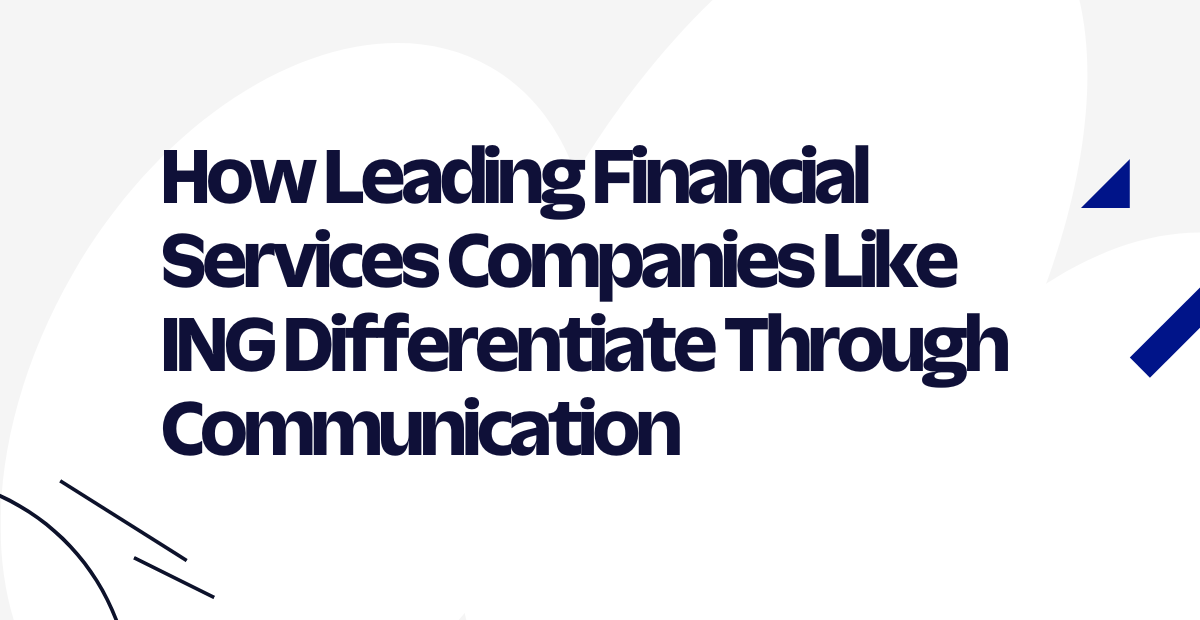How Leading Financial Services Companies Like ING Differentiate Through Communication
Time to read: 4 minutes

From managing an online checking account to communicating with a mortgage advisor, today’s mobile customers are used to receiving texts and other messages from the financial services companies with whom they do business.
Payment-due reminders, low balance alerts, and suspicious activity warning notifications are all essential bits of information that shouldn’t end up in an email inbox. Customers need — and want — to receive these messages in real-time and via SMS, in-app chats, push notifications, and popular services like Facebook Messenger, WhatsApp, and other over-the-top (OTT) messaging applications.
Outside of regulatory compliance, customer retention is the biggest challenge facing financial services firms. According to a Customer Think study, retail banking customer acquisition costs hover around $200.
With the average customer generating about $150 in revenue each year, a financial business would need to retain that customer for more than a year and a half just to recoup those costs.
That’s why forward-looking financial services companies understand the benefits of keeping customers for a lifetime. They’ve stepped up their communications by using messaging to build dynamic, interactive relationships throughout the entire customer journey—engaging, delighting, and ultimately retaining their customers over the long haul. Here are five examples of how leading financial services companies use messaging to set themselves apart with differentiated communications.
CU Wireless and how they connect with customers on their preferred channels
Mobile banking allows customers to quickly request information and make transactions on their mobile devices. In an ongoing effort to improve customer experience — and to keep up with today’s technology innovations — more and more banks are adding the option for customers to use SMS, in-app chat, or OTT platforms to conduct routine banking transactions, such as checking their balances or making a payment.
CU Wireless — a subsidiary of Maps Credit Union — provides cutting-edge banking technology to the members of 300 credit unions around the country. They offer customers instant, text-based access to their balance, account history, and more through Maps Text Banking.
The use of SMS and push notifications are efficient and effective ways to keep customers updated on their financial accounts with real-time alerts. For example, banks might find that using SMS is the most direct way to communicate an account fraud alert or a transaction completion because text messages are succinct and easy for the recipient to digest. With real-time SMS notifications, customers who might have otherwise contacted our support team now have a more convenient way of getting updates.
Xoom and their use of real-time SMS updates
Xoom, a digital money transfer provider and member of the PayPal family, helps consumers send money, pay bills, and reload a family member’s prepaid mobile phone credits from anywhere in the world.
Xoom has several channels that allow customers to get status updates on their money transfers, including phone, email notifications, and in-portal information, but many of them chose real-time text messages, powered by Twilio SMS, as their preferred alert channel. Customers can opt-in to receive an SMS account alert when the funds are deposited, picked up, or delivered.
Xoom also enables those receiving funds to get real-time SMS updates. If the customer wants “Mom” to be notified when the money is available for pick-up, he simply opts her in to receive SMS alerts by entering his mother's mobile number after creating the money transfer. Now, instead of having to wait for the person sending the money to provide a status update (which is made more challenging if the parties are many time zones apart), recipients get accurate, real-time SMS alerts in their preferred language.
TransferWise and their security-centric customer experience
Account takeovers have a significant impact on financial institutions, costing typically $10,000 to $15,000 per account. Offering users a secure 2FA solution is the quickest way to move them beyond using passwords alone to protect their accounts and high-value transactions.
TransferWise is an international peer-to-peer money transfer platform that lets users send money around the world faster, more conveniently, and up to eight times cheaper than traditional banks. Every month, the company moves over £1.2 billion in customer funds between more than 50 countries. Their success comes with great responsibility: no matter how fast, convenient, and affordable their service is, if their customers’ data gets breached, their business suffers.
Simply Business and their use of contextual customer information to grow trust
Context is the key to creating great conversations and exceptional customer experiences. As customers interact with multiple touchpoints across the organization, it’s critical to ensure agents—and bots—are informed every step of the way to fuel insightful conversations.
Simply Business, recently acquired by Travelers Insurance, is the UK’s leading business insurance broker and protects more than 300,000 small businesses nationwide. To increase the efficiency of their contact center employees, the company built an intelligent contact center from scratch by leveraging Twilio APIs.
By integrating customer information from multiple sources into a single view, Simply Business is able to provide agents with the real-time data and context they need to provide personalized customer experiences across multiple channels.
ING and their focus on reliable, trustworthy partners
Cloud-based APIs make it easy for businesses to build the experiences their customers want and expect. But not all cloud communication providers are created equal.
To support evolving customer demand, financial services companies must focus their search on providers who offer scale, reliability, and flexibility. First and foremost, the provider should have an extensive global network with carrier relationships around the world to reach customers wherever they are.
The platform must be able to provide a rich set of communication channels and capabilities while being scalable enough to handle high volumes and spikes in traffic. Finally, it’s critical to find a quality network platform that will automatically optimize messaging traffic routes to ensure quality performance and delivery, every time.
ING, one of the largest multinational financial service organizations, knew that as the financial needs of their global banking customers evolved, they had to grow with them. Since ING’s customers use mobile apps as a primary means to communicate, the organization understood that to remain relevant in today’s market, they had to completely change the way they interact with customers.
Since finance is so heavily regulated, it was imperative for ING to choose a reliable and secure cloud communications provider to transform its next-generation contact center. Working with Twilio allowed ING to meet industry and regulatory compliance requirements, ensure their customers would have access to reliable and high-quality communication channels and reach their global customer base through a single provider.
Related Posts
Related Resources
Twilio Docs
From APIs to SDKs to sample apps
API reference documentation, SDKs, helper libraries, quickstarts, and tutorials for your language and platform.
Resource Center
The latest ebooks, industry reports, and webinars
Learn from customer engagement experts to improve your own communication.
Ahoy
Twilio's developer community hub
Best practices, code samples, and inspiration to build communications and digital engagement experiences.


